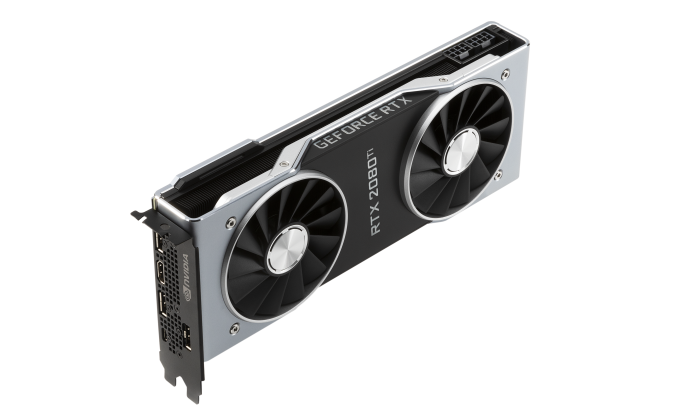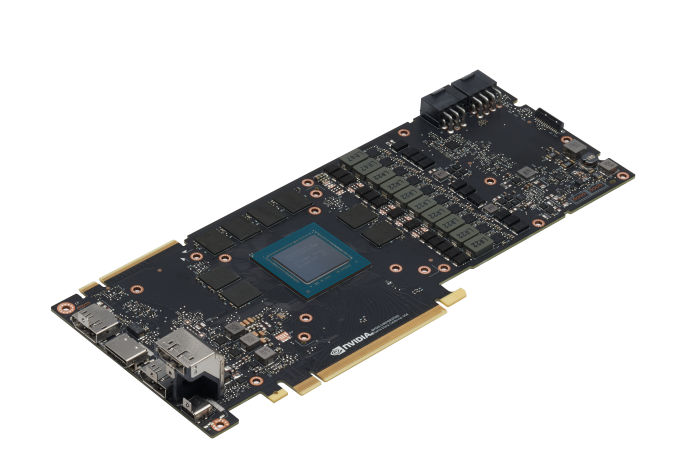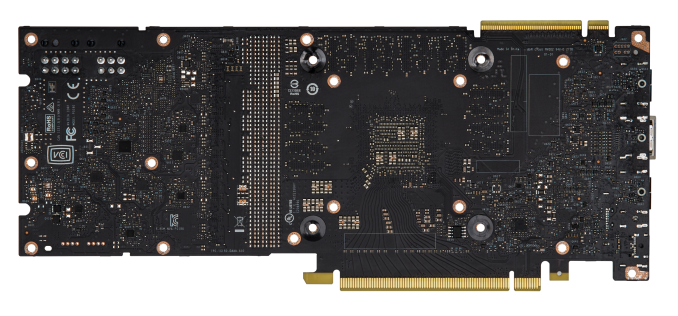The NVIDIA GeForce RTX 2080 Ti & RTX 2080 Founders Edition Review: Foundations For A Ray Traced Future
by Nate Oh on September 19, 2018 5:15 PM EST- Posted in
- GPUs
- Raytrace
- GeForce
- NVIDIA
- DirectX Raytracing
- Turing
- GeForce RTX
Meet The GeForce RTX 2080 Ti & RTX 2080 Founders Editions Cards
Moving onto the design of the cards, we've already mentioned the biggest change: a new open air cooler design. Along with the Founders Edition specification changes, the cards might be considered 'reference' in that they remain a first-party video card sold direct by NVIDIA, but strictly-speaking they are not because they no longer carry reference specifications.
Otherwise, NVIDIA's industrial design language prevails, and the RTX cards bring a sleek flattened aesthetic over the polygonal shroud of the 10 series. The silver shroud now encapsulates an integrated backplate, and in keeping with the presentation, the NVLink SLI connectors have a removable cover.
Internally, the dual 13-blade fans accompany a full-length vapor chamber and component baseplate, connected to a dual-slot aluminum finstack. Looking at improving efficiency and granular power control, the 260W RTX 2080 Ti Founders Edition features a 13-phase iMON DrMOS power subsystem with a dedicated 3-phase system for the 14 Gbps GDDR6, while the 225W RTX 2080 Founders Edition weighing in with 8-phases main and 2-phases memory.
As is typical with higher quality designs, NVIDIA is pushing overclocking, and for one that means a dual 8-pin PCIe power configuration for the 2080 Ti; on paper, this puts the maximum draw at 375W, though specifications-wise the TDP of the 2080 Ti Founders Edition against the 1080 Ti Founders Edition is only 10W higher. The RTX 2080 Founders Edition has the more drastic jump, however, with 8+6 pins and a 45W increase over the 1080's lone 8 pin and 180W TDP. Ultimately, it's a steady increase from the power-sipping GTX 980's 165W.
One of the more understated changes comes with the display outputs, which thanks to Turing's new display controller now features DisplayPort 1.4 and DSC support, the latter of which is part of the DP1.4 spec. The eye-catching addition is the VR-centric USB-C VirtualLink port, which also carries an associated 30W not included in the overall TDP.
Something to note is that this change in reference design, combined with the seemingly inherent low-volume nature of the Turing GPUs, cuts into an often overlooked but highly important aspect of GPU sales: big OEMs in the desktop and mobile space. Boutique system integrators will happily incorporate the pricier higher-end parts but from the OEM’s perspective, the GeForce RTX cards are not just priced into a new range beyond existing ones but also bringing higher TDPs and no longer equipped with blower-style coolers in its ‘reference’ implementation.
Given that OEMs often rely on the video card being fully self-exhausting because of a blower, it would certainly preclude a lot of drop-in replacements or upgrades – at least not without further testing. It would be hard to slot into the standard OEM product cycle at the necessary prices, not to mention the added difficulty in marketing. In that respect, there is definitely more to the GeForce RTX 20 series story, and it’s somewhat hard to see OEMs offering GeForce RTX cards. Or even the RT Cores themselves existing below the RTX 2070, just on basis of the raw performance needed for real time ray tracing effects at reasonable resolutions and playable framerates. So it will be very interesting to see how the rest of NVIDIA’s product stack unfolds.
















337 Comments
View All Comments
Hixbot - Friday, September 21, 2018 - link
I'm not sure how midrange 2070/2060 cards will sell if they're not a significant value in performance/price compared to 1070/1060 cards. If AMD offer no competition, Nvidia should still compete with itselfWwhat - Saturday, September 22, 2018 - link
It's interesting that every comment I've seen says a similar thing and that nobody thinks of uses outside of gaming.I would think that for real raytracers and Adobe's graphics and video software for instance the tensor and RT cores would be very interesting.
I wonder though if open source software will be able to successfully use that new hardware or that Nvidia is too closed for it to get the advantages you might expect.
And apart from raytracers and such there is also the software science students use too.
And with the interest in AI currently by students and developers it might also be an interesting offering.
Although that again relies on Nvidia playing ball a bit.
michaelrw - Wednesday, September 19, 2018 - link
"where paying 43% or 50% more gets you 27-28% more performance"1080 Ti can be bought in the $600 range, wheres the 2080 Ti is $1200 .. so I'd say thats more than 43-50% price increase..at a minimum we're talking a 71% increase, at worst 100% (Launch MSRP for 1080 Ti was $699)
V900 - Wednesday, September 19, 2018 - link
Which is the wrong way of looking at it.NVIDIA didn’t just increase the price for shit and giggles, the Turing GPUs are much more expensive to fab, since you’re talking about almost 20 BILLION transistors squeezed into a few hundred mm2.
Regardless: Comparing the 2080 with the 1080, and claiming there is a 70% price increase, is a bogus logic in the first place, since the 2080 brings a number of things to the table that the 1080 isn’t even capable of.
Find me a 1080ti with DLSS and that is also capable of raytracing, and then we can compare prices and figure out if there’s a price increase or not.
imaheadcase - Wednesday, September 19, 2018 - link
In brings it to the table..on paper more like it. You literally listed the two things that are not really shown AT ALL.mscsniperx - Wednesday, September 19, 2018 - link
No, actually YOUR logic is bogus. Find me a DLSS or Raytracing game to bench.. You can't. There is a reason for that. Raytracing will require a Massive FPS hit, Nvidia knows this and is delaying you from seeing that as damage control.Yojimbo - Wednesday, September 19, 2018 - link
There are no ray tracing games because the technology is new, not because NVIDIA is "delaying them". As far as DLSS, I think those games will appear faster than ray tracing.Andrew LB - Thursday, September 20, 2018 - link
Coming soon:Darksiders III from Gunfire Games / THQ Nordic
Deliver Us The Moon: Fortuna from KeokeN Interactive
Fear The Wolves from Vostok Games / Focus Home Interactive
Hellblade: Senua's Sacrifice from Ninja Theory
KINETIK from Hero Machine Studios
Outpost Zero from Symmetric Games / tinyBuild Games
Overkill's The Walking Dead from Overkill Software / Starbreeze Studios
SCUM from Gamepires / Devolver Digital
Stormdivers from Housemarque
Ark: Survival Evolved from Studio Wildcard
Atomic Heart from Mundfish
Dauntless from Phoenix Labs
Final Fantasy XV: Windows Edition from Square Enix
Fractured Lands from Unbroken Studios
Hitman 2 from IO Interactive / Warner Bros.
Islands of Nyne from Define Human Studios
Justice from NetEase
JX3 from Kingsoft
Mechwarrior 5: Mercenaries from Piranha Games
PlayerUnknown’s Battlegrounds from PUBG Corp.
Remnant: From The Ashes from Arc Games
Serious Sam 4: Planet Badass from Croteam / Devolver Digital
Shadow of the Tomb Raider from Square Enix / Eidos-Montréal / Crystal Dynamics / Nixxes
The Forge Arena from Freezing Raccoon Studios
We Happy Few from Compulsion Games / Gearbox
Funny how the same people who praised AMD for being the first to bring full DX12 support yet only 15 games in the first two years used it, are the same people sh*tting on nVidia for bringing a far more revolutionary technology that's going to be in far more games in a shorter time span.
jordanclock - Thursday, September 20, 2018 - link
Considering AMD was the first to bring support to an API that all GPUs could have support for, DLSS is not a comparison. DLSS is an Nvidia-only feature and Nvidia couldn't manage to have even ONE game on launch day with DLSS.Manch - Thursday, September 20, 2018 - link
AMD spawned Mantle which then turned into Vulcan. Also pushed MS to dev DX12 as it was in both their interests. These APIs can be used by all.DLSS while potentially very cool, is as Jordan said proprietary. Like hair works and other crap ot will get light support but devs when it comes to feature sets will spend most of their effort building to common ground. With consoles being AMD GPU based, guess where that will be.
If will be interesting how AMD will ultimatley respond. Ie gsync/freesync CUDA/OpenCL, etc.
As Nvidia has stated, these features are designed to work with how current game engines already function so they dont (the devs) have to reinvent the wheel. Ultimately this meanz the integration wont be very deep at least not for awhile.
For consumers the end goal is always better graphics at the same price point when new releases happen.
Not that these are bad cards, just expensove and two very key features are unavailable, and that sucks. Hopefully the situation will change sooner rather than later.